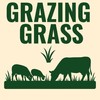
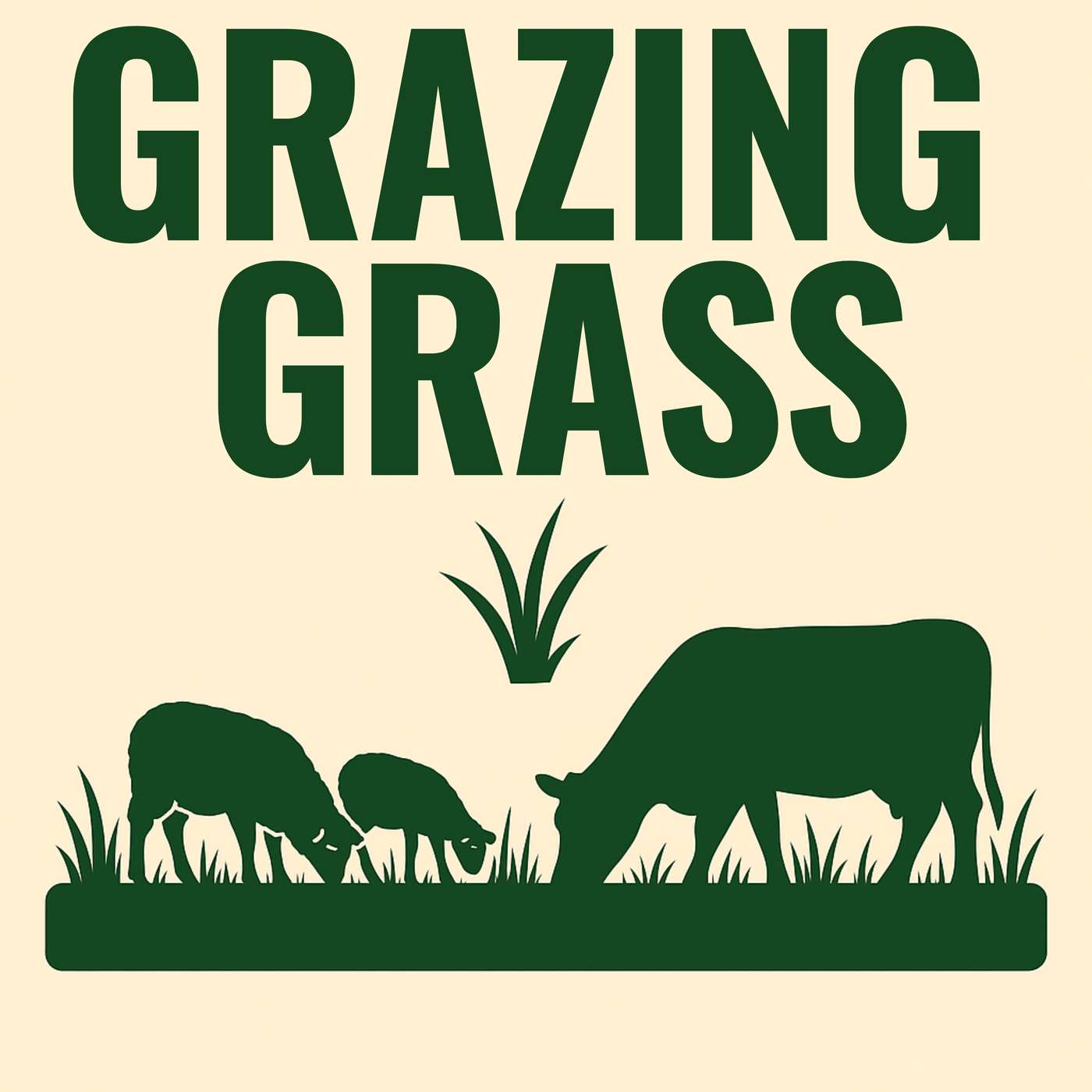
Grazing Grass Podcast sharing Regenerative Ag Stories
Grazing Grass
The Grazing Grass Podcast features insights and stories of regenerative farming, specifically emphasizing grass-based livestock management. Our mission is to foster a community where grass farmers can share knowledge and experiences with one another. We delve into their transition to these practices, explore the ins and outs of their operations, and then move into the "Over Grazing" segment, which addresses specific challenges and learning opportunities. The episode rounds off with the "Famous Four" questions, designed to extract valuable wisdom and advice. Join us to gain practical tips and inspiration from the pioneers of regenerative grass farming.
This is the podcast for you if you are trying to answer: What are regenerative farm practices? How to be grassfed? How do I graze other species of livestock? What's are ways to improve pasture and lower costs? What to sell direct to the consumer?
This is the podcast for you if you are trying to answer: What are regenerative farm practices? How to be grassfed? How do I graze other species of livestock? What's are ways to improve pasture and lower costs? What to sell direct to the consumer?
Episodes
Mentioned books
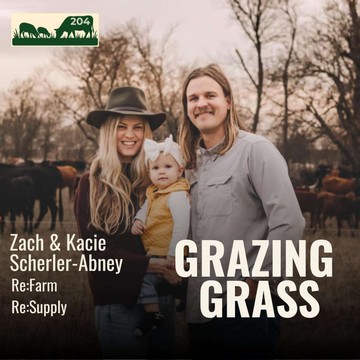
Dec 31, 2025 • 1h 19min
204 | Zach & Kacie Scherler-Abney, Re:Farm & Re:Supply
Zach (first-generation) and Kacie (fifth-generation) Scherler-Abney are ranchers operating Re:Farm and Re:Supply in Cotton and Tillman Counties in southwest Oklahoma, running a cow-calf herd with some stockers while also managing land for others and operating retail stores in Norman, Oklahoma and Wichita Falls, Texas. In This Episode, We Explore: - How a personal health scare led them back to the family place and into raising their own food - Using an autoimmune protocol diet as a catalyst to question food labels and sourcing - Learning regenerative grazing through books, YouTube, and early hands-on trial and error - Grazing in a more brittle, variable rainfall environment in southwest Oklahoma and north Texas - Ultra high-density, non-selective grazing and why recovery time is the key variable for them - What polywire taught them, and why quality of life and labor forced a change - Building water systems with HDPE poly pipe, quick couplers, and central lanes for flexibility - Leasing strategies including Oklahoma state school land (CLO) and BIA tribal land leases - Transitioning to Halter virtual fencing and what changed in daily management and stress - How their cattle buying philosophy shifted to phenotype, productivity, and pounds per acre - Marketing reality checks: balancing direct-to-consumer beef with current sale barn economics - Why they built brick-and-mortar stores and how non-perishables help stabilize cash flow - Community-building through retail and sourcing other local products beyond their own beef Why This Episode Matters This conversation is a practical look at matching grazing goals to real life, especially when labor, family time, leases, and cash flow are all limiting factors. Zach and Kacie share what worked, what wore them out, what they changed, and how they think about staying flexible without abandoning the core principles that keep land and livestock improving. Resources Mentioned - Halter virtual fencing system - Passon quick couplers - Oklahoma Commissioners of the Land Office (CLO) grazing leases - Bureau of Indian Affairs (BIA) grazing leases Find Out More - Instagram | re:farm - Website | Re:Farm Market - Facebook | Re:Farm
Looking for Livestock that thrive on grass? Check out Grass Based GeneticsUpcoming Grazing EventsVisit our Sponsors:Noble Research InstituteRedmond AgricultureGrazing Grass LinksWebsiteCommunity (on Facebook)Original Music by Louis Palfrey

Dec 24, 2025 • 1h 24min
203 | Matt Goble, Dry Bottom Farms
Matt Goble joins the Grazing Grass Podcast to share how he’s built a profitable, resilient wool sheep operation in a high-elevation mountain valley using entirely private and marginal land. While working a full-time W-2 job, Matt manages 450 ewes with a strong focus on grazing efficiency, soil health, and thoughtful breeding decisions. His system blends management-intensive grazing, cover crops, and perennial pastures, all adapted to a short growing season and limited irrigation.In this episode, we cover:Grazing irrigated pasture and marginal land in a mountain valleyUsing cover crops to build soil before establishing perennial pastureManaging sheep with daily and multi-day grazing movesLambing systems, jug management, and efficiency at scaleBreeding strategies for maternal traits and terminal lambsUsing ear notching and simple visual systems to reduce decision fatiguePredator pressure and why net fencing matters for sheepBalancing stocking rates during drought yearsAdding chickens and turkeys to improve soil and diversify incomeMatching enterprise scale to land capacity and lifestyle goalsWhy This Episode Matters: This conversation is a clear example of how management, not acres, often determines success. Matt shows how intentional grazing, simple systems, and observation can double productivity without doubling land or inputs. His practical insights into lambing efficiency, breeding decisions, and drought planning offer valuable lessons for anyone managing livestock on limited or challenging ground.Resources Mentioned:The Soil Owner’s Manual by John StikaThe Art and Science of Shepherding (Premier 1 Supplies)Field Area Measure (mobile app)Find Out More:Facebook: Dry Bottom FarmsSnow College Agriculture Department (Utah)
Looking for Livestock that thrive on grass? Check out Grass Based GeneticsUpcoming Grazing EventsVisit our Sponsors:Noble Research InstituteRedmond AgricultureGrazing Grass LinksWebsiteCommunity (on Facebook)Original Music by Louis Palfrey
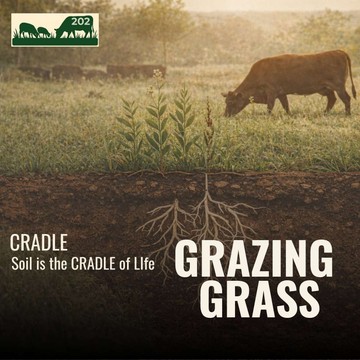
Dec 19, 2025 • 9min
202. Soil Is the CRADLE of Life: A Better Way to Remember Soil Health Principles
In this Field Notes episode, Cal slows things down to share a simple way to think about soil health principles that actually sticks when you’re in the pasture. Instead of another list to memorize, this episode introduces CRADLE, a practical framework that organizes well-known soil health principles into something easier to remember and apply in real-world conditions.In this episode, we explore:Why soil health principles are easy to understand but hard to recall in real-world decision momentsHow context shapes the way soil health principles are applied on different operationsHow the core soil health ideas fit together through the CRADLE frameworkWhere disturbance, soil cover, diversity, living roots, and livestock fit within that bigger pictureA simple way to step back and diagnose what might be missing when things aren’t working as expectedWhat CRADLE stands for:C — ContextR — Reduce DisturbanceA — Armor on the SoilD — DiversityL — Living RootsE — Embrace LivestockWhy listen to this episode?If you understand soil health principles but struggle to recall or apply them under real-world pressure, this episode gives you a mental model you can actually use. CRADLE helps move soil health from theory into day-to-day decision-making — without adding complexity.Looking aheadNext week’s Field Notes tackles a listener question on low-cost corral options, focusing on what actually matters, what you can skip, and practical ways to work animals safely without overspending on infrastructure.Thanks to our partnersField Notes is made possible by the continued support of Noble Research Institute and Redmond Agriculture. Their commitment to soil health education and stewardship helps make these conversations possible.More grass. Better soil. Happier livestock. Keep on grazing, and we’ll see you next week.
Looking for Livestock that thrive on grass? Check out Grass Based GeneticsUpcoming Grazing EventsVisit our Sponsors:Noble Research InstituteRedmond AgricultureGrazing Grass LinksWebsiteCommunity (on Facebook)Original Music by Louis Palfrey

Dec 17, 2025 • 1h 21min
201. Intentional Grazing in a Cold Climate with Jacob Morin
In Episode 201 of the Grazing Grass Podcast, Cal Hardage sits down with Jacob Morin of Target Angus and Le Paysan Gourmand in Quebec. Jacob shares how a college humanities class unexpectedly set him on a path toward regenerative agriculture and how he and his family transitioned a conventional cow-calf operation into a diversified, grass-based farm. Together, they discuss intentional grazing, winter management in cold climates, infrastructure decisions that make daily moves possible, and how direct-to-consumer beef, market gardening, and livestock diversification work together to support the next generation on the farm.Topics covered in this episode include:Intentional grazing and adaptive decision-makingWinter grazing and bale grazing in cold climatesGrazing infrastructure: fencing, water systems, and daily movesDirect-to-consumer beef sales and pricing challengesDiversification with vegetables, hogs, and value-added productsTransitioning family farms and planning for future generationsLessons learned from trial, error, and staying flexibleWhy you should listen: This episode is packed with real-world insight for producers navigating cooler climates, land constraints, and direct marketing. Jacob’s story highlights how thoughtful grazing, diversification, and intentional choices can build resilience—both in the soil and in the family running the operation. If you’re balancing tradition with change or looking for practical ideas to strengthen your grazing system, this conversation will resonate.Resources mentioned in the episode:Target AngusLe Paysan GourmandSalad Bar Beef by Joel SalatinPastured Poultry Profits by Joel SalatinThe Bold Return of Giving a Damn by Will Harris
Looking for Livestock that thrive on grass? Check out Grass Based GeneticsUpcoming Grazing EventsVisit our Sponsors:Noble Research InstituteRedmond AgricultureGrazing Grass LinksWebsiteCommunity (on Facebook)Original Music by Louis Palfrey
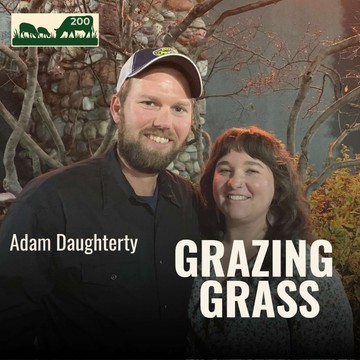
Dec 10, 2025 • 1h 10min
200. Starting a Grazing System with Limited Time and Budget with Adam Daugherty
Adam Daugherty joins us from southern Indiana to share the story of how a few cows, some encouragement from family, and a willingness to try rotational grazing transformed his operation. Adam talks through the early days of partnering with his grandfather and great-aunt, the moment rotational grazing finally “clicked,” and how semi-permanent fencing, flexible water systems, and strategic winter feeding have reshaped his pastures. He also walks us through his approach to genetics, cow size, docility, and marketing calves directly to a feedlot rather than selling through a barn—plus what he wishes new graziers would know before they start.Topics CoveredGetting started with cattle through family partnershipsHow one brother-in-law pushed him toward rotational grazingUsing fiberglass posts and high-tensile wire as low-cost subdivision fencingBuilding water hubs, temporary pipelines, and later upgrading to buried linesUsing a movable tank and quick-connect valves for efficient daily movesHow rotational grazing changed pasture health, weed pressure, and animal behaviorManaging winter feeding with concrete pads and strategic hay unrollingBenefits of a sacrifice paddock—and why we shouldn’t be afraid to use oneBuying and developing genetics within the family herdManaging docility and safety while working a W2 jobTheir marketing system: preconditioning and selling directly to a local feedlotFuture plans: warm-season grasses, tire-tank siphon systems, and refining geneticsWhy You Should ListenAdam exemplifies the reality for many graziers: juggling off-farm jobs, limited time, and a desire to do better with what you already have. His story is packed with practical, low-cost ideas—from fencing to water to winter feeding—that can help new and seasoned graziers rethink their systems. If you’ve ever felt too busy to start rotational grazing or unsure where to begin, Adam’s journey will show you exactly how doable it can be.Resources MentionedLocal NRCS & Soil and Water offices (mapping, design, & technical support)Graber Farm Supply (fiberglass posts & materials)Purdue’s Southern Indiana research farm (SIPAC)Daily Manufacturing bale unroller
Looking for Livestock that thrive on grass? Check out Grass Based GeneticsUpcoming Grazing EventsVisit our Sponsors:Noble Research InstituteRedmond AgricultureGrazing Grass LinksWebsiteCommunity (on Facebook)Original Music by Louis Palfrey
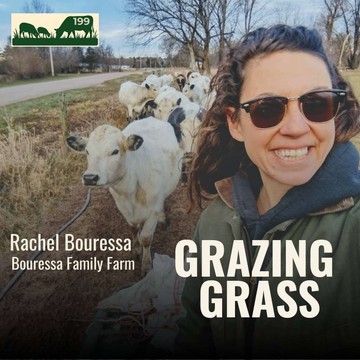
Dec 3, 2025 • 1h 17min
199. Soil-First Grazing and Earned Efficiency with Rachel Bouressa
Rachel Bouressa of Bouressa Family Farm joins us from central Wisconsin, where she’s a fifth-generation farmer and second-generation grazier managing 120 acres with a soil-first mindset. After returning home following a barn fire, she rebuilt her operation using perennial forages, diverse annuals, and a willingness to experiment. Today she’s deeply involved with Grassworks, Wisconsin Farmers Union, NRCS conservation planning, women-in-conservation mentoring, and the Upper Fox Wolf Demonstration Farm Network—all while running a thriving direct-to-consumer beef business.Topics Covered in This EpisodeRebuilding the family farm after a barn fire and starting with just 15 acresDeveloping a soil-first grazing philosophy and “earned efficiency”Working closely with NRCS and building strong planner–farmer relationshipsConverting row-crop ground back to pasture using rye, diverse cool-season mixes, and sorghum-SudanChoosing cattle genetics: British White Parks, Devons, and Murray GreysDirect-to-consumer beef sales and transitioning to Barn2DoorExtending the grazing season toward ChristmasAudubon Bird-Friendly certification and creating habitat valueWhy You Should ListenIf you’re looking for a grounded, real-world example of what soil-first grazing looks like in practice, Rachel brings hard-earned wisdom, humility, and a spirit of experimentation. Her story is full of practical insights—from pasture renovation to breed selection to extending the grazing season—and she offers a refreshingly honest look at the challenges and rewards of growing a regenerative, community-connected grazing operation.Resources MentionedGrassworks ConferenceNRCS grazing resourcesAudubon Conservation Ranching ProgramWendell Berry — Unsettling of America, The Gift of Good LandFred Provenza — Nourishment
Looking for Livestock that thrive on grass? Check out Grass Based GeneticsUpcoming Grazing EventsVisit our Sponsors:Noble Research InstituteRedmond AgricultureGrazing Grass LinksWebsiteCommunity (on Facebook)Original Music by Louis Palfrey
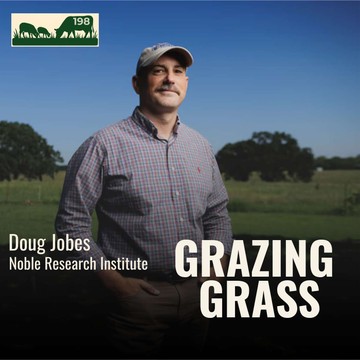
Nov 26, 2025 • 1h 15min
198. Adding Wildlife Income Streams to Your Ranch with Doug Jobes
Today’s episode features Doug Jobes, Regenerative Ranching Advisor at the Noble Research Institute, whose background spans rural Georgia agriculture, the 75th Ranger Regiment, wildlife science, and rangeland ecology. Doug brings a wildlife-first lens to grazing—not just how animals eat grass, but how grazing decisions ripple out into birds, deer, turkeys, insects, habitat structure, and even the income potential of your ranch.We dig into how wildlife and grazing fit together, what habitat components matter most, how producers can inventory wildlife on their land, and how regenerative grazing opens doors to additional enterprises like hunting leases, ecotourism, and wildlife photography. Doug also explains nesting cover vs. roost sites for turkeys, how to adapt your grazing plan for wildlife without sacrificing profitability, and why “realistic expectations” matter more than anything when managing both grass and critters.Topics CoveredDoug’s journey from Georgia farm life → military service → wildlife science → Noble Research Institute.What “regenerative grazing + wildlife” really means.Why realistic expectations are key when managing habitat.How to inventory wildlife on your property.Differences in wildlife presence between neighboring properties—and why.Monetizing wildlife:Hunting leasesWaterfowl accessDove fieldsFishingEcotourismWildlife photography (and how competitive photographers are!)Habitat needs for:Bobwhite quailGrassland songbirdsWild turkeys—nesting cover + roost treesHow grazing decisions influence bird populations (Roots So Deep examples).Using rest periods strategically for wildlife habitat.The Rangeland Analysis Platform (RAP) as a tool for understanding forage history.Doug’s favorite book → Beef, Brush, and BobwhitesWhy market forces matter in conservation decisions.🎧 Why Listen?If you’ve ever wondered how wildlife fits into regenerative ranching—or how your grazing decisions affect far more than cattle—this episode will open your eyes. Doug connects soil health, plant communities, wildlife needs, grazing pressure, and producer profitability in a way few people can. You’ll walk away with a clearer understanding of habitat, new options for income streams, and several practical management tweaks you can apply immediately.This episode is especially valuable if you’ve been noticing wildlife differences between your property and the neighbors and wondering “why?”Resources MentionedNoble Research Institute: https://noble.orgBeef, Brush, and Bobwhites — Guthery & Hernández (ebook ~$10)Rangeland Analysis Platform (RAP): https://rangelands.appRoots So Deep docuseries (bird habitat comparisons)Looking for Livestock that thrive on grass? Check out Grass Based GeneticsVisit our Sponsors:Noble Research InstituteRedmond Agriculture.Grazing Grass LinksNew Listener Resource GuideProvide feedback for the podcastWebsiteInsidersResourcesCommunity (on Facebook)Check out the Apiary Chronicles PodcastOriginal Music by Louis Palfrey
Looking for Livestock that thrive on grass? Check out Grass Based GeneticsUpcoming Grazing EventsVisit our Sponsors:Noble Research InstituteRedmond AgricultureGrazing Grass LinksWebsiteCommunity (on Facebook)Original Music by Louis Palfrey
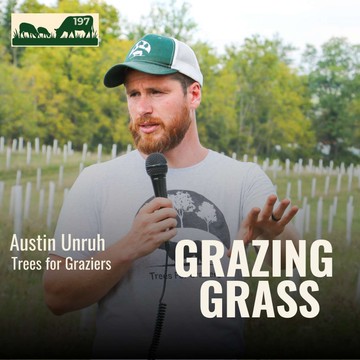
Nov 19, 2025 • 1h 10min
197. Silvopasture in the Real World with Austin Unruh
Austin Unruh returns for another deep, practical conversation on silvopasture — this time focusing on “the dip,” livestock pressure, pruning, shade strategy, pigs and poultry in tree systems, and what to do in Year Zero before you ever put a seedling in the ground. If you’ve ever stared at your pastures on a hot day wishing you had more shade… this one will light a fire under you.What we cover in this episode:The “dip” in silvopasture: why years 1–4 feel like a grindShade as the low-hanging fruit — and why it’s only the beginningLivestock pressure: how to protect trees when cattle, horses, and wildlife want to destroy themPruning young vs. established trees (and the dangers of over-pruning)Species selection for different goals: shade, fodder, privacy screens, and livestock feedWhy mulberries and persimmons shine for pigs and poultryRunning pigs IN establishment-phase silvopasture (pros, cons, protection methods)Tree spacing, patterns, and why grids usually beat random placementsManaging compaction, vole pressure, and bark hardeningYear Zero → Year Two: fall tasks, maintenance, ordering trees, and setting up for successWhy early wins matter psychologically (and how to get them)Continuous grazing vs rotational grazing when it comes to tree cropsIf you’re serious about silvopasture, this episode gives you a roadmap from the ground up — from species selection and timing to realistic maintenance and livestock integration. Austin breaks down the parts most graziers underestimate: the grind, the setbacks, and the discipline it takes before shade and feed finally show up. Whether you’re planting five trees or five hundred, you’ll walk away with clearer steps and fewer unknowns.Resources mentioned:Trees for Graziers — treesforgraziers.comCastor oil vole deterrent productsAcres U.S.A. (publisher of Austin’s upcoming second edition)Liberty apple, crabapple, and apple-crab varietiesHybrid willow, hybrid poplar, black locust, honey locustRusted Plowshare Farm (Josh Payne)Looking for Livestock that thrive on grass? Check out Grass Based GeneticsVisit our Sponsors:Noble Research InstituteRedmond Agriculture.Grazing Grass LinksNew Listener Resource GuideProvide feedback for the podcastWebsiteInsidersResourcesCommunity (on Facebook)Check out the Apiary Chronicles PodcastOriginal Music by Louis Palfrey
Looking for Livestock that thrive on grass? Check out Grass Based GeneticsUpcoming Grazing EventsVisit our Sponsors:Noble Research InstituteRedmond AgricultureGrazing Grass LinksWebsiteCommunity (on Facebook)Original Music by Louis Palfrey

Nov 12, 2025 • 1h 24min
196. Regenerative Grazing and Direct Marketing Success with Leslie Svacina
Leslie Svacina, a grass-based farmer and educator, shares her journey from wholesale to a successful direct-to-consumer model at Cylon Rolling Acres. She discusses managing a mixed flock of goats and Texel sheep under rotational grazing, the creative use of lower-grade fleece, and her thriving subscription meat sales business. Leslie provides insights on inventory management, customer acquisition through email marketing, and her educational resources, including a Goat Meat Primer eBook. Her practical advice is perfect for aspiring producers!
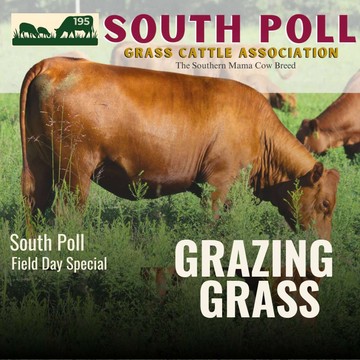
Nov 5, 2025 • 2h 2min
195. South Poll Field Day Special: Real Ranchers, Real Results
In this special in-person episode recorded at the South Poll Field Day, Cal sits down with some of the biggest names connected to the South Poll breed and regenerative grazing movement — Teddy Gentry, Greg Judy, Ralph & Jerry Voss, Steve Freeman, and Nathan Hahn.You’ll hear the story of how the South Poll breed was created, the philosophy behind it, and how it continues to thrive on real-world farms. From developing heat-tolerant genetics and maintaining fertility in tough environments to direct-to-consumer beef and breeding program strategies, this episode captures a living snapshot of regenerative cattle culture in action.Guests include:🧬 Teddy Gentry — Founder of the South Poll breed, sharing its origin, composite makeup, and the importance of fertility, longevity, and line breeding for efficiency.🌱 Greg Judy — Missouri grazier explaining how South Polls transformed his operation, reduced inputs, and made it possible to quit his off-farm job.👩🌾 Ralph & Jerry Voss — Longtime breeders whose herd and friendship with Greg Judy led to some of the most influential South Poll genetics today.🐄 Steve Freeman — Missouri cattleman with over 40 years of experience, describing how South Polls helped him achieve 95% conception rates and a truly profitable grass-only system.🥩 Nathan Hahn — Kentucky farmer finishing and selling beef direct-to-consumer, detailing how South Polls fit perfectly into a low-input, grass-finished operation.Why You Should ListenWhether you raise South Polls or not, this episode is packed with wisdom about:Selecting for fertility and longevity over size or EPDs.Building a profitable cow herd that thrives on grass alone.Breeding and marketing strategies for grass-fed genetics.The real-world economics and mindset shifts behind regenerative ranching.How smaller, calmer, efficient cattle can make you money — and peace of mind.It’s part history lesson, part grazing masterclass, and a celebration of the community driving the South Poll breed forward.Resources MentionedSouth Poll Grass Cattle AssociationGreg Judy – Green Pastures FarmVoss South PollsUnity FarmsLooking for Livestock that thrive on grass? Check out Grass Based GeneticsVisit our Sponsors:Noble Research InstituteRedmond Agriculture.Grazing Grass LinksNew Listener Resource GuideProvide feedback for the podcastWebsiteInsidersResourcesCommunity (on Facebook)Check out the Apiary Chronicles PodcastOriginal Music by Louis Palfrey
Looking for Livestock that thrive on grass? Check out Grass Based GeneticsUpcoming Grazing EventsVisit our Sponsors:Noble Research InstituteRedmond AgricultureGrazing Grass LinksWebsiteCommunity (on Facebook)Original Music by Louis Palfrey


